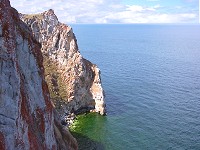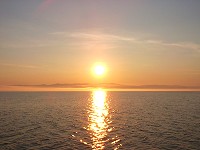| Origin & Development | |
|
Legends & Fairy tales • Earth's Crust Thickness • Underwater Relief • Landscapes • History & Formation • Seismic Activity • | |
| History of Lake Baikal | |
|
History of Explorations • Inhabitants & Settlers • First maps of Baikal • Archaeological Sites • | |
| Lake Baikal Climate | |
|
Introduction • Fogs • Winds & Waves • Ice Conditions • | |
| Fauna & Vegetation | |
|
Mammals • Baikal seal - Nerpa • Ichthyofauna • Invertebrates • Vegetation • | |
| Water of Lake Baikal | |
|
Colour • Transparency • Temperature • Pressure • Depth • Currents • Budget • Chemical Composition • Pollution • | |
| Recreational Areas | |
|
Circumbaikal Railway • Peschanaya Bays • Olkhon Island • Chivirkuysky Gulf • Wooden Irkutsk • Trans-Siberian Railway • | |
| People of Lake Baikal | |
|
People of Siberia • Buryat nation in Baikal • Russians in Baikal • | |
|
| |
| Baikal History & Formation Mechanism Geological and Geophysical Data
Individual parts of the Baikal basin, which is currently united, were considered by geologists and geographers as being developed at different times. Some basins subsided more, some less. But this process took place in one and the same geological period, the Tertiary. Even in the initial stages of formation, the basins of baikalian type represented beds of more or less large lakes, connected by rivers, and could constitute a gigantic united system, like the present lakes of the Laurenty system in North America. The Baikal became united late in Pliocene - early in Quaternary. Opinions on mechanisms and history of the Baikal basin formation differ. Investigators of the XVIII century regarded it to be a sink. Chersky believed that the Baikal basin is a result of slow and progressive transformation of folds in Laurentian rocks. Then the assumptions of the XVIII century have undergone a change and the Baikal was considered to be a large graben, and according to Zuss, a combination of two grabens, originally divided by mountains, which extend from Olkhon island to Svyatoy Nos peninsula. V.A.Obruchev: "It is deep, wide and its slopes are too steep and abrupt. Such a depression could be formed solely by disjunctive crustal movements and is comparatively recent in age, otherwise its steep slopes would have been smoothed out owing to washout, and the lake would have been filled with the slope products".
GEOLOGICAL & Geophysical Data Geological age of Lake Baikal: Pre-rift (pre-baikalian) period (Cretaceous-Late Eocene): 70 - 35 million years Rift period: 30 - 0 million years a) protobaikalian (early baikalian) stage (Oligocene - Early Pliocene): 30 - 3.5 million years b) neobaikalian (proper baikalian) stage (Pliocene - Holocene): 3.5 - 0 million years The age of deposits on the Baikal shores: Tompuda River moraine: 39000 years Rel River moraine: 25580 years +/- 350 years Chernozems silts on the first baikalian terraces (Holocene optimum) approximately: 7000 years Peat bogs of Chivirkuy Bay: 10000 - 12000 years | ||||||

